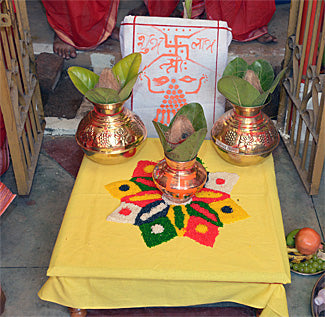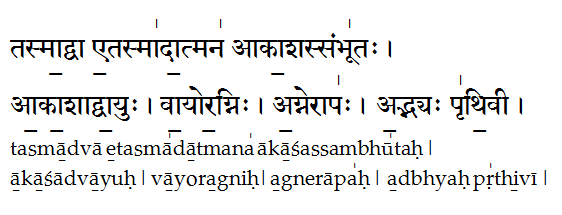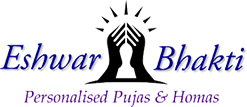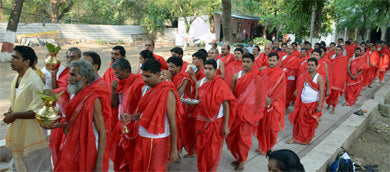Why Choose Us ?

|
||
 Brahmin Bhojan (food offering to the Pundits) |
 Maha Aarti (with musical instruments) |
|
What is Puja ?
Puja is ritualistic worship of the Divine performed to keep us in harmony with cosmic forces, thereby removing and overcoming the sorrows of life and bringing spiritual upliftment. By doing puja, thoughts and vibrations of spiritual forces are created around us. These spiritual forces work to eliminate the negative influences in our life and help surround us with positive energy which can bring us peace of mind, material prosperity and enable us to more clearly touch the Divine, our true nature.
Pujas are traditionally performed in temples by residing priests trained in the exact science of Hinduism puja including the precise details of auspicious times to do certain pujas, which mantras to chant, etc. An individual's vedic astrological chart determines which pujas and timings are best for that person, based on their karma from this life and previous lives.
The periods when the results of our past actions, favorable or unfavorable, come to fruition are indicated by planetary positions at the time of our birth. A great deal about the events and influences of life can be predicted through the science of Jyotish (Vedic Astrology). The malefic effects which are destined to befall us can be averted or their effects reduced by the grace of God, sincere prayer, selfless service and performance of specific pujas as recommended in the scriptures. The happiness we create in the lives of other people, and nature as a whole, will give us benefits as well. The body, mind and spirit are purified and harmonized by meditation, acts of devotion, prayers, mantra japa and the pujas we perform.
Hindu ritual is meant to inculcate feelings of devotion and religiosity and thereby bring God and spirituality into the center human life. Hinduism ceremonies can be defined as family ceremonies, caste ceremonies. and village ceremonies. They can be as simple lighting a flame before a deity or as complex as an initiation ceremony for a young Brahmin with music, chants, recitations and offerings that last for hours.
BENEFITS OF PUJA
Whatever you are engaged in, you must always be thinking of God. This is the purpose of Hindu rituals. Rituals will foster good habits and they will bring order in life. Every Hindu ritual was created as an aid to maintain an unbroken remembrance of God.
We can enhance the benefit of the puja by doing spiritual practices or by taking certain vows. Some of the commonly observed practices include meditation, fasting, silence, prayer, mantra japa or repeating God's name, and charity. These vows can be done for one day, one week or as long as you wish. The result of these actions is to help purify us and to enable us to imbibe more deeply the spiritual energy invoked by the Hinduism pooja.
SELECT A PUJA
Do I need to Have My Vedic Astrology Chart Analyzed?
An analysis of the vedic birth chart is not necessary to have a puja performed, or to receive the benefit of any puja. The merit which is earned by doing a puja will come to fruition at the appropriate time in our life. However, a more precise understanding of our specific karma, and the timetable for the unfoldment of our karma, can be determined by a competent astrologer.
How do I select a Puja?
Please refer to the list of Puja Yagya / Yajna / Online Homam Hinduism Puja Service here. Planetary pujas are commonly requested based on an analysis of one's birth chart.
Please also refer to the List of Various Types of Vedic Yagya Homa Rituals / Hindu Puja List / Rituals List / Hindu Ceremonies List
What is Homa Homam Homas ? and Significance of Homas
Homa is a sacred fire ritual done in the Vedic Hindu tradition. Homa is a technique given by the Rishis and other Enlightened Masters to create a specific desired effect in our lives. The way in which the desired effect is made and the strength of the effect makes Homa a unique component of Vedic tradition.
Homa means a Hindu ritual, wherein an oblation or any religious offering is made into fire. The Homa is also called "sacrifice ritual" because the fire destroys the offering, but a Homa is more accurately a "votive ritual". The fire is the agent, and the offerings include those that are material and symbolic such as grains, clarified butter, milk, incense and seeds. It is rooted in the Vedic religion, and was adopted in ancient times by Buddhism and Jainism. The practice spread from India to Central Asia, East Asia and Southeast Asia. Homa rituals remain an important part of many Hinduism pooja ceremonies, and variations of Homa continue to be practiced in current-day Buddhism, particularly in parts of Tibet and Japan.
Shorter version of Homam, which can be done by an individual on his own is called as Agnihotra Homa. Know what is Agnihotra - Benefits, Agnihotra Procedure and Agnihotra Mantras here .
The Vedas explain the process of creation. It says …

The pure consciousness manifested in the form of space. Then out of space, wind was created. Out of wind, fire was created and out of fire, water was created and out of water, earth was created.
Fire is the subtest element yet perceivable by eyes. So in the Vedic Hindu tradition, fire is used as a medium to invoke the presence of God. In a homa the priest first meditates on the Lord and energizes the space. This energy is transferred to the air element by the chanting of mantras, which in turn energizes the fire in the homa kunda – the sacred fire receptacle. The energy built up in the fire is then transferred to the water in the Kalasas – the water pots kept there. The water when sprinkled or poured on us / on a Deity transfers the whole energy on to the Earth element.
Book Homas from Online Pooja Sites here
Also the fire is the medium through which the formless energy assumes the form and the matter with the form gets back to its original state of energy. Devi Meenakshi is said to have emerged out of Homa fire. The great saint Tirujnanasambandhar and the great incarnation Vallalar have dissolved their bodies in the yogic fire. The living incarnation Paramahamsa Nithyananda also has used the fire of Arunachala mountain to assume His physical body.
Whatever our prayers can be, they can be manifested into reality through the sacred fire of Homas.
In a typical Hindu Homa, a priest invokes the presence of the Deity in the fire through specialized mantras. Since mantras are revealed by Enlightened sages, all mantras carry immense power within them. Once energized, till the end of the homa, the fire itself becomes a deity. Then the Deity is worshipped and several oblations (ahutis) are offered into the fire to create the desired effect. The smoke that emanates from the fire receptacle – homa kunda – energizes the whole space where the homa is done and creates a positive effect in that place.
Homas create a positive effect not only in the people who are around but also in the people whose names have been chanted in the Sankalpa mantra – the mantra for conscious resolution, irrespective of how far they are. Know what is Sankalpa?
Another very interesting speciality of the way of worship in the Hindu tradition is – like how money is credited in an account which is far away from the place where the money is deposited, homas and pujas done as per the scriptural injunctions create the desired effect in you irrespective of how far you are from the place where the homa /puja is performed.
The energy built up in the homa fire automatically reaches the participant and fulfils the participant’s true desires leaving a glimpse of Jeevan Mukti in the participant.
Book Online Puja Service / Hinduism Pooja Rituals in Hindu tradition





- Choosing a selection results in a full page refresh.

